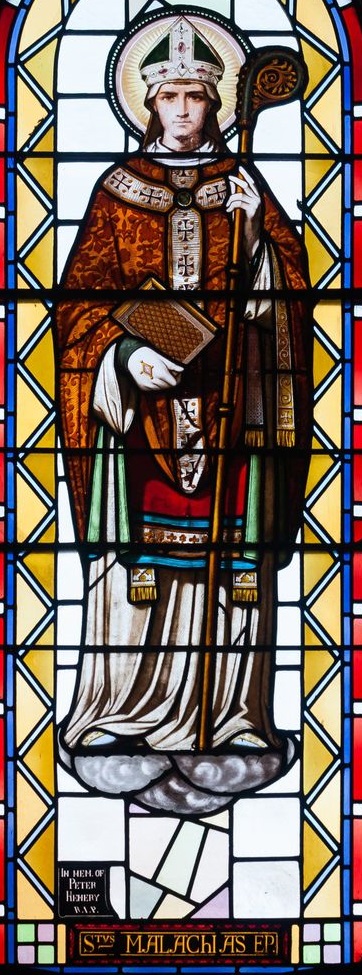
Much of the material below is distilled from Omnium Santorum Hiberniae
St. Malachy was of noble birth whose family surname was Ua Morgair. He was born in Armagh in 1094. His Irish baptism name was Máel-M’áedóc. His father, Mugrón, was ard-fher légind (chief lector or chief scholar) of Armagh. His family was of an ecclesiastical line of Cenél Conaill, a dynasty of Uí Néill. His mother, was most solicitous to train him up in the fear of God.
He received his formation in Armagh from Ímar Ua hÁedacáin, a reform-minded monk. Malachy was very studious, and he far outstripped his fellow-students in learning. He also developed a strong spiritual life and became an ascetic. Malachy was ordained deacon by Ímar c.1118, some years after the reform synod of Rath Breasail in 1111. He was then ordained a priest by the comarba Pátraic (Successor of St. Patrick), by Cellach (Celsus) in 1119. Rev. Cellach was a strong advocate for reform. Under his influence, Malachy advanced his studies in sacred liturgy and theology, down south in Lismore; a predominantly Gaelic diocese, and a pro-reform foundation. He studied for two years under St. Malchus. There also, Malachy came into contact with Máel-Ísu Ua hAinmire, bishop of the small diocese of Waterford, which was a predominantly viking diocese. Máel-Ísu Ua hAimnire was also a strong advocate of reform. He was a Benedictine monk who had studied at Winchester and was well informed on Roman canonical and liturgical practice.
Malachy was thus, destined to reform the Irish ecclesial church. He later became the Abbot of Bangor, in 1123, and became bishop of Down & Connor at age thirty, and then reluctantly became Archbishop of Armagh, in 1132, succeeding Cellach. During his term in possession at Armagh, St. Malachy reformed church discipline, and promoted the Roman Liturgy, in favour of the Celtic traditions. Malachy re-established Christian morals, to the point that he felt able to resign in 1138, with the view to return to the diocese of Down & Connor. He divided two sees of Connor and Down and consecrated another bishop for Connor, reserving for himself the small diocese of Down.
He travelled to Rome in 1139 via York in Great Britain, and Clairvaux in France, visiting St. Bernard. The Clairvaux saint wrote a hagiographical tribute on The Life and Death of Saint Malachy. At Yvree in Piedmont, Malachy restored to health the child of the host with whom he lodged, who was at the point of death. At Rome, the Irish saint sought from Pope Innocent, palliums for the Sees of Armagh and Cashel. He did not succeed in this request, but got a promise of such, and Malachy returned home as legate for Ireland. His role was to oversee church reform. On his return trip, at Clairvaux he was given five monks for the Mellifount abbey to be (1142). St. Malachy travelled back to Ireland through Scotland, and restored king David’s dangerously ill son Henry to perfect health. During Malahy’s period back in Ireland, he travelled across the country in the role of papal legate, promoting church reform and establishing of Augustinian chapters at some of the Irish cathedrals.
Malachy convened in 1148 a synod at Inis Pátraic in Dublin. There a decision was made in principle to seek four pallia – for Armagh, Cashel, Dublin, and Tuam. Malachy undertook a journey to meet Pope Eugenius in France. But he fell ill in Clairvaux dying in the care of St. Bernard, on 2 November of his age fifty-four. Though he passed away, his desire for the pallia and the diocesan organisation he had worked hard to promote, was to be realised at the synod of Kells–Mellifont in 1152.
Malachy was the very first formally canonized Irish Saint. He was canonised by Pope Clement (III), on 6 July, 1199. His feast is celebrated on 3 November.
